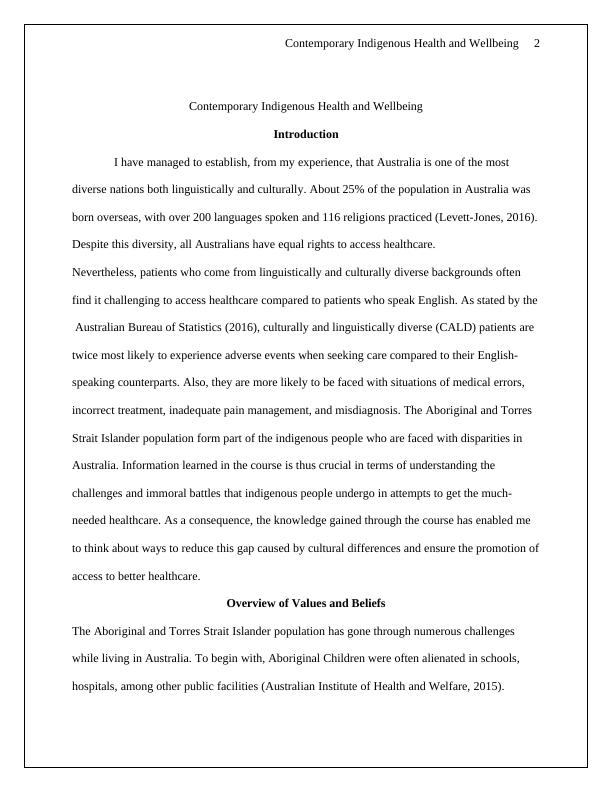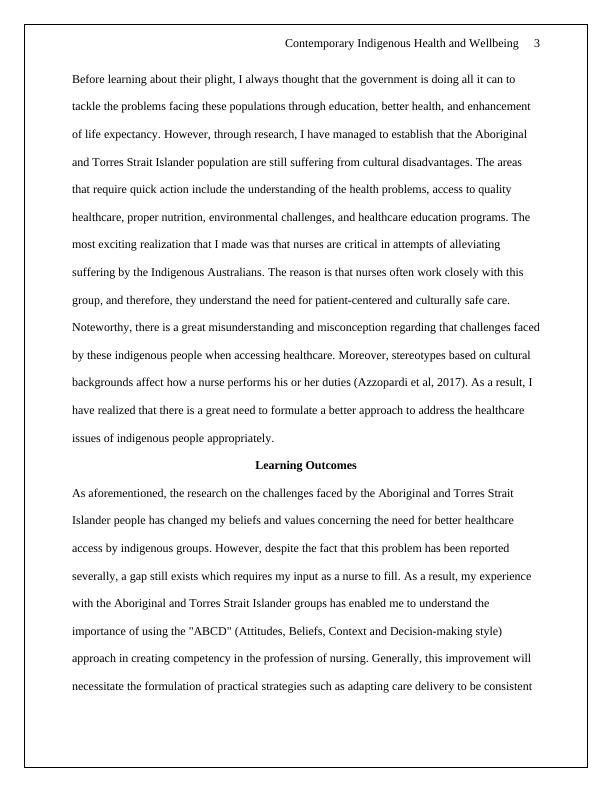Contemporary Indigenous Health and Wellbeing
Added on 2022-11-22
8 Pages1920 Words496 Views
Contemporary Indigenous Health and Wellbeing 1
CONTEMPORARY INDIGENOUS HEALTH AND WELLBEING
By (Name)
Course
Institution
Instructor
City and State
Date
CONTEMPORARY INDIGENOUS HEALTH AND WELLBEING
By (Name)
Course
Institution
Instructor
City and State
Date

Contemporary Indigenous Health and Wellbeing 2
Contemporary Indigenous Health and Wellbeing
Introduction
I have managed to establish, from my experience, that Australia is one of the most
diverse nations both linguistically and culturally. About 25% of the population in Australia was
born overseas, with over 200 languages spoken and 116 religions practiced (Levett-Jones, 2016).
Despite this diversity, all Australians have equal rights to access healthcare.
Nevertheless, patients who come from linguistically and culturally diverse backgrounds often
find it challenging to access healthcare compared to patients who speak English. As stated by the
Australian Bureau of Statistics (2016), culturally and linguistically diverse (CALD) patients are
twice most likely to experience adverse events when seeking care compared to their English-
speaking counterparts. Also, they are more likely to be faced with situations of medical errors,
incorrect treatment, inadequate pain management, and misdiagnosis. The Aboriginal and Torres
Strait Islander population form part of the indigenous people who are faced with disparities in
Australia. Information learned in the course is thus crucial in terms of understanding the
challenges and immoral battles that indigenous people undergo in attempts to get the much-
needed healthcare. As a consequence, the knowledge gained through the course has enabled me
to think about ways to reduce this gap caused by cultural differences and ensure the promotion of
access to better healthcare.
Overview of Values and Beliefs
The Aboriginal and Torres Strait Islander population has gone through numerous challenges
while living in Australia. To begin with, Aboriginal Children were often alienated in schools,
hospitals, among other public facilities (Australian Institute of Health and Welfare, 2015).
Contemporary Indigenous Health and Wellbeing
Introduction
I have managed to establish, from my experience, that Australia is one of the most
diverse nations both linguistically and culturally. About 25% of the population in Australia was
born overseas, with over 200 languages spoken and 116 religions practiced (Levett-Jones, 2016).
Despite this diversity, all Australians have equal rights to access healthcare.
Nevertheless, patients who come from linguistically and culturally diverse backgrounds often
find it challenging to access healthcare compared to patients who speak English. As stated by the
Australian Bureau of Statistics (2016), culturally and linguistically diverse (CALD) patients are
twice most likely to experience adverse events when seeking care compared to their English-
speaking counterparts. Also, they are more likely to be faced with situations of medical errors,
incorrect treatment, inadequate pain management, and misdiagnosis. The Aboriginal and Torres
Strait Islander population form part of the indigenous people who are faced with disparities in
Australia. Information learned in the course is thus crucial in terms of understanding the
challenges and immoral battles that indigenous people undergo in attempts to get the much-
needed healthcare. As a consequence, the knowledge gained through the course has enabled me
to think about ways to reduce this gap caused by cultural differences and ensure the promotion of
access to better healthcare.
Overview of Values and Beliefs
The Aboriginal and Torres Strait Islander population has gone through numerous challenges
while living in Australia. To begin with, Aboriginal Children were often alienated in schools,
hospitals, among other public facilities (Australian Institute of Health and Welfare, 2015).

Contemporary Indigenous Health and Wellbeing 3
Before learning about their plight, I always thought that the government is doing all it can to
tackle the problems facing these populations through education, better health, and enhancement
of life expectancy. However, through research, I have managed to establish that the Aboriginal
and Torres Strait Islander population are still suffering from cultural disadvantages. The areas
that require quick action include the understanding of the health problems, access to quality
healthcare, proper nutrition, environmental challenges, and healthcare education programs. The
most exciting realization that I made was that nurses are critical in attempts of alleviating
suffering by the Indigenous Australians. The reason is that nurses often work closely with this
group, and therefore, they understand the need for patient-centered and culturally safe care.
Noteworthy, there is a great misunderstanding and misconception regarding that challenges faced
by these indigenous people when accessing healthcare. Moreover, stereotypes based on cultural
backgrounds affect how a nurse performs his or her duties (Azzopardi et al, 2017). As a result, I
have realized that there is a great need to formulate a better approach to address the healthcare
issues of indigenous people appropriately.
Learning Outcomes
As aforementioned, the research on the challenges faced by the Aboriginal and Torres Strait
Islander people has changed my beliefs and values concerning the need for better healthcare
access by indigenous groups. However, despite the fact that this problem has been reported
severally, a gap still exists which requires my input as a nurse to fill. As a result, my experience
with the Aboriginal and Torres Strait Islander groups has enabled me to understand the
importance of using the "ABCD" (Attitudes, Beliefs, Context and Decision-making style)
approach in creating competency in the profession of nursing. Generally, this improvement will
necessitate the formulation of practical strategies such as adapting care delivery to be consistent
Before learning about their plight, I always thought that the government is doing all it can to
tackle the problems facing these populations through education, better health, and enhancement
of life expectancy. However, through research, I have managed to establish that the Aboriginal
and Torres Strait Islander population are still suffering from cultural disadvantages. The areas
that require quick action include the understanding of the health problems, access to quality
healthcare, proper nutrition, environmental challenges, and healthcare education programs. The
most exciting realization that I made was that nurses are critical in attempts of alleviating
suffering by the Indigenous Australians. The reason is that nurses often work closely with this
group, and therefore, they understand the need for patient-centered and culturally safe care.
Noteworthy, there is a great misunderstanding and misconception regarding that challenges faced
by these indigenous people when accessing healthcare. Moreover, stereotypes based on cultural
backgrounds affect how a nurse performs his or her duties (Azzopardi et al, 2017). As a result, I
have realized that there is a great need to formulate a better approach to address the healthcare
issues of indigenous people appropriately.
Learning Outcomes
As aforementioned, the research on the challenges faced by the Aboriginal and Torres Strait
Islander people has changed my beliefs and values concerning the need for better healthcare
access by indigenous groups. However, despite the fact that this problem has been reported
severally, a gap still exists which requires my input as a nurse to fill. As a result, my experience
with the Aboriginal and Torres Strait Islander groups has enabled me to understand the
importance of using the "ABCD" (Attitudes, Beliefs, Context and Decision-making style)
approach in creating competency in the profession of nursing. Generally, this improvement will
necessitate the formulation of practical strategies such as adapting care delivery to be consistent

End of preview
Want to access all the pages? Upload your documents or become a member.
Related Documents
Contemporary Indigenous Health and Wellbeinglg...
|8
|2052
|465
Media’s Influence on the Health and Wellbeing of Aboriginal and Torres Strait Islander Peoplelg...
|19
|3252
|258
Contemporary Indigenous Health and Wellbeinglg...
|7
|1916
|49
HLSC120: Society, Culture and Healthlg...
|12
|2744
|274
Cultural Safety in Healthcarelg...
|8
|2356
|201
Indigenous Health Perspectives: Bawrunga Aboriginal Medical Servicelg...
|12
|1816
|129
